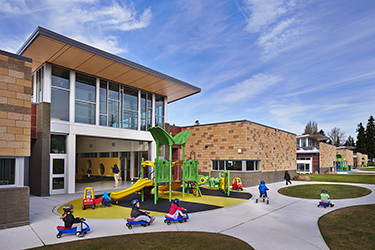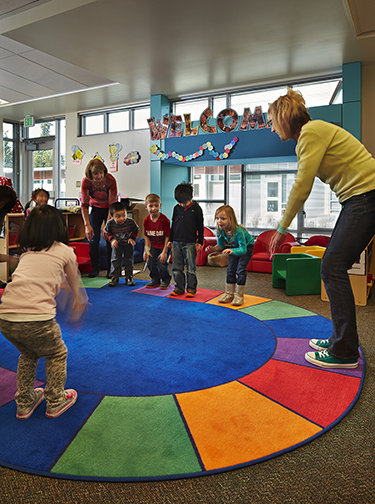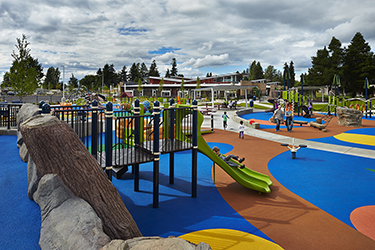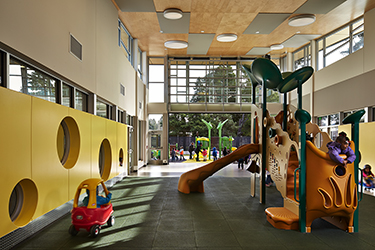|
Subscribe / Renew |
|
|
Contact Us |
|
| ► Subscribe to our Free Weekly Newsletter | |
| home | Welcome, sign in or click here to subscribe. | login |
Construction
| |
 |
August 28, 2014
Renton preschool offers kids a running start
BLRB Architects

Cottrill
|
According to the National Education Association, providing quality early learning programs for children before they turn 5 yields significant lifetime benefits. In one study, individuals who were enrolled in a quality preschool program ultimately earned up to $2,000 more per month than those who were not.
Children in early learning programs are less likely to repeat grades, need special education or manifest behavioral problems. High school graduation rates, home ownership and even marriage statistics have all been found to be influenced by early childhood education.
While human brain development is a lifelong process, the brain’s plasticity and receptivity to learning and enrichment is never greater than in early childhood. In fact, 90 percent of human brain development occurs between birth and age 5, making early learning programs critical to establishing the basis for future scholastic success.
There is then arguably no age group for which a thoughtful, tailored approach to educational architecture can have a more critical impact than in the pre-kindergarten years.
Focus on early learning
| |
|
Renton School District Project manager: Greene Gasaway Architect: BLRB Architects General contractor: Porter Brothers Construction Civil engineer: AHBL Engineers Structural engineer: PCS Structural Solutions Mechanical/electrical engineer: BCE Engineers Landscape architect: Thomas V. Rengstorf & Associates |
Most often treated as a program element within the context of a larger facility, early learning is given primacy at the Renton School District’s Meadow Crest Early Learning Center. Completed in September 2013, this new 68,800-square-foot early learning center is wholly dedicated to a wide variety of educational and support programs serving the educational and developmental needs of children aged 3 to 5, many with physical, psychological or developmental disabilities, and their families.
Sited in an economically disadvantaged urban area, Meadow Crest serves a preponderance of non-English-speaking and low-income families. Accordingly, the district sought to develop a facility that, while providing educational and support services to young children, also offers resource and referral services to parents in an environment that is welcoming and inclusive to all.
Meadow Crest’s federally funded Head Start program offers preschool and family support services, including community resource and emergency assistance referrals, child health screenings and parent engagement opportunities. The Early Childhood Education and Assistance Program offers similar services and is state-funded. Both are available to families meeting specific income thresholds.
The center also features an inclusive preschool program in which children with special needs learn alongside typically developing children, providing educational and social benefit to both. Other specialized programs include Extended Day for children with autism, and Child Find, a program that provides free developmental screenings for children aged 3 to 5.
Engaging the senses
Brain development, research tells us, is activity-dependent. Interactive experiences encompassing sensory, motor, emotional and cognitive functions stimulate and shape the way neural pathways develop and set the stage for future learning. Every experience excites some neural circuits and leaves others inactive.
Those circuits that are consistently “turned off” over time may be dropped away, a process that can have permanent implications for learning capacity in subsequent years. This is why multimodal early education programming is key to overall child development.
Between the neuroscience of brain development and the unique space requirements of early learning programs, one might ask how bricks and mortar can aspire to address the range of physical space needs while optimizing developmental and educational outcomes. The answer, at Meadow Crest, is very well.
Overarching design priorities were driven by the specialized needs of the early learning program and the small stature of Meadow Crest’s students. Personalization of learning spaces, facility flexibility and adaptability, provision for student safety and supervision, and facility zoning and security were chief among them.
One of Meadow Crest’s thematic design elements is the integration of “experience opportunities” that engage and stimulate children’s senses — sight, smell, touch, taste and hearing — throughout the facility. Organized into three distinct classroom wings accessible through a central reception area, Meadow Crest offers a visual feast of color, shapes and forms immediately upon entry, and throughout circulation and learning areas.
Classrooms were designed to be flexible and interchangeable to accommodate multiple programs, variable class sizes, unique program requirements and future changes in educational programming.
Multipurpose rooms and meeting spaces adaptable for a variety of school functions and events, and are segregated from student areas to preserve security while permitting public access and use.
Small-school environment
The intimate nature of the wing concept creates a small-school environment within the context of the overall facility. Beyond inspiring feelings of safety and belonging in small children, this organizational model enhances safety and security by allowing a high degree of student visibility and staff supervision capacity.
Material, graphics and aesthetic choices create an organizational flow that helps both children and adults find their way, eliminating the need for reading skills, an important strategy in serving a high proportion of non-English-speaking students and families.
Each classroom wing has a unique insect mascot and color theme identifier, and infusion of the overarching nature theme via environmental graphics and digital wall coverings. Unexpected patterns in the floor coverings present themselves in circulation areas, offering children spontaneous play and kinetic learning opportunities.
Places to discover
Corridors connecting the educational wings feature tall windows with “right-sized” nooks that create scaled discovery opportunities for children on their travels between spaces. Peekaboo viewing portals and small platform seats near windows allow children to get up close and personal with outdoor vistas. One-way mirrors offer exploration and play opportunities for children while also affording discrete student assessment and observation vantage points for staff.
Shared indoor play courts between the classroom wings are accessible from each classroom. Floor-to-ceiling windows fill play areas with natural light and allow children to experience the outdoors on even the rainiest of Pacific Northwest days.
The play courts offer multiple surface types, passive and interactive play opportunities and a variety of equipment that builds motor skills including riding, climbing and balancing. Movable glass walls on the south side of each play court can be fully opened, blurring the indoor/outdoor division and providing access to the adjacent inclusive playground.
American statesman and 19th-century education reformer Horace Mann famously said that “education, then, beyond all other devices of human origin, is the great equalizer of the conditions of men.”
At Meadow Crest Early Learning Center, educators work to equalize the playing field for students’ scholastic and life success in a facility that’s tailor-made to meet the unique physical, developmental and educational needs of the children they serve.
Andy Cottrill is a senior associate with BLRB Architects and was the project designer and architect for the Meadow Crest Early Learning Center.
Other Stories:
- Can you design a school theater that pleases everyone?
- What schools can learn from Starbucks
- How replacing an old building is like selling New Coke
- Locals designers help rebuild schools in Haiti damaged by earthquake
- What to consider when building a new school next to the old one
- WSU technology lab combines work with show
- Do art and science mix? Lab designers give it a try






